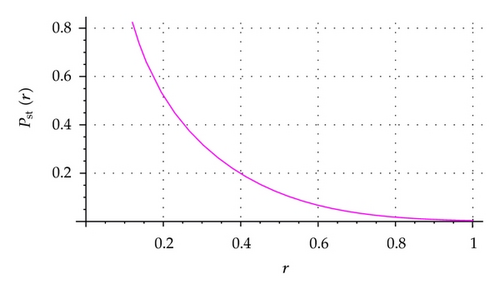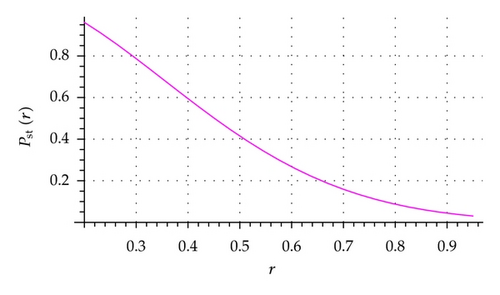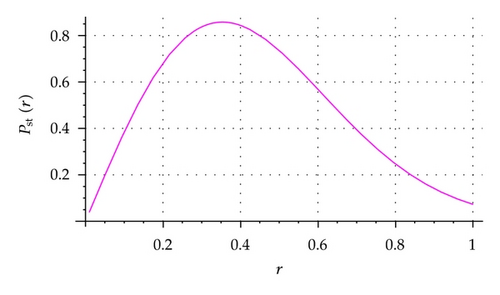Deterministic and Stochastic Bifurcations of the Catalytic CO Oxidation on Ir(111) Surfaces with Multiple Delays
Abstract
The main purpose is to investigate both deterministic and stochastic bifurcations of the catalytic CO oxidation. Firstly, super- and subcritical bifurcations are determined by the signs of the Poincaré-Lyapunov coefficients of the center manifold scalar bifurcation equations. Secondly, we explore the stochastic bifurcation of the catalytic CO oxidation on Ir(111) surfaces with multiple delays according to the qualitative changes in the invariant measure, the Lyapunov exponent, and the stationary probability density of system response. Some new criteria ensuring stability and stochastic bifurcation are obtained.
1. Introduction
For most of the practical cases, the dynamical systems will be disturbed by some stochastic perturbation. There are real benefits to be gained in using stochastic rather than deterministic models. It could be intuitively thought that the external noise would smear out the finer details of the nonlinear system, such as bifurcations between well-defined states. However, it could also happen that noise forces the system far away from its deterministic attractors to explore regions of phase space that are otherwise not visited or interact with the nonlinearities giving rise to new phenomena [1–10].
Now, a great care should be taken when reducing the internal/external sources of noise and uncertainties such as thermal noise, observation errors, and model misspecification. The CO oxidation on platinum group crystals offers an experimental setup, where the nonlinear mechanisms have been captured with high accuracy, and sources of internal noise are controlled. The CO oxidation on crystals shows, in the absence of noise, a wide variety of phenomena, for example, oscillations, bistability, bifurcation, excitability, spatiotemporal patterns, and turbulence. These reactions have been receiving an increasing attention as a laboratory analogy of catalysis used at the industrial level to manufacture chemical products and process harmful species. Understanding the effects of external noise on this oxidation reaction can be considered as an effort to bridge the quality gap. Besides material and pressure gap, which have been discussed in the literature before, the quality gap separates small experiments in perfectly controlled settings and the industrial processes that are always under the influence of uncertainties.
In this paper, we investigate the deterministic and stochastic bifurcations of the catalytic CO oxidation on Ir(111) surfaces with multiple delays. Mechanisms and parameters are known with a high degree of accuracy, and the relevant parameters can be controlled. These ideal properties make it possible to go back and forth between theory and experiments. Our paper focuses on homogeneous states and builds on the work of Hayase et al. [11–18] who studied experimentally and numerically the effect of noise on CO oxidation on Ir(111). They verified that the mathematical model was correct and observed probability distributions that are consistent with the presence of multiplicative noise.
The structure of the paper is as follows. In Section 2, we analyzed the single and double Hopf bifurcation of deterministic system. In Section 3, we analyzed the stochastic stability and bifurcation of stochastic system.
2. Deterministic System
Lemma 1. The transversality conditions ℜe(dλ/dγ)λ=ωi = −ac − bd ≠ 0 hold. If the choice of values for the model parameters is such that the inequality
This means that the pair of eigenvalues λ1,2 = v(γ) + iω(γ) of Δ(λ, γ) = 0 with v(γc) = 0, ω(γc) ≠ 0 will cross the imaginary axis from left to right in the complex plane with a nonzero speed as the bifurcation parameter γ varies near its critical value γc. Also, it ensures that the steady-state stability of the system is lost at γ = γc, and the instability in the sense of supercritical and subcritical bifurcations will persist for larger values of γ. The exact nature of such bifurcations satisfying Hopf’s conditions ((6)–(12)) will depend on the nonlinearity in the delay system.
These are the minimum values separating the regimes of stable and unstable solutions of the linearized delay equation at the Hopf bifurcation point γ = γc, . Below and equal to these minimum values, all the infinite numbers of eigenvalues of the transcendental characteristic equation (6) will lie in the left-hand side of the complex plane.
2.1. The Single Hopf Bifurcation
Consequently, the constant matrices B ∈ 𝒞 and are equivalent, and the elements of B at the Hopf bifurcation are B = [[0, ω] ⊤, [−ω, 0] ⊤].
2.2. The Double Hopf Bifurcation
3. Stochastic System
In the section, we present some preliminary results to be used in a subsequent section to establish the stochastic stability and stochastic bifurcation. Before proving the main theorem, we give some lemmas and definitions.
Definition 3 (see [1] D-bifurcation.)Dynamical bifurcation is concerned with a family of random dynamical systems which is differential and has the invariant measure μα. If there exists a constant αD satisfying in any neighborhood of αD, there exists another constant α and the corresponding invariant measure να ≠ μα satisfying να → μα as α → αD. Then, the constant αD is a point of dynamical bifurcation.
Definition 4 (see [1] P-bifurcation.)Phenomenological bifurcation is concerned with the change in the shape of density (stationary probability density) of a family of random dynamical systems as the change of the parameter. If there exists a constant α0 satisfying in any neighborhood of αD, there exist other two constants α1, α2, and their corresponding stationary density functions , satisfying and are not equivalent. Then, the constant α0 is a point of phenomenological bifurcation.
Definition 5 (see [1] stochastic pitchfork bifurcation.)In the viewpoint of phenomenological bifurcation, the stationary solution of the Fokker-Planck-Kolmogorov (FPK) equation which is corresponded with the stochastic differential equation changes from one peak into two peaks.
In the viewpoint of dynamical bifurcation, there exists a constant μ0 that satisfies the following conditions:
- (i)
when μ < μ0, the stochastic differential equation has only one invariant measure ν0; moreover, ν0 is stable (i.e., the maximal Lyapunov exponent is negative).
- (ii)
when μ = μ0, the invariant measure ν0 loses its stability and becomes unstable (i.e., the maximal Lyapunov exponent is positive); moreover, the rotation number is zero.
- (iii)
when μ > μ0, the stochastic differential equation has three invariant measures ν0, ν1, and ν2; both ν1 and ν2 are stable (i.e., their maximal Lyapunov exponents are both negative).
- (iv)
the global attractors of the stochastic differential equation change from a single-point set into a collection of one-dimensional (the closure of the unstable manifold of the unstable invariant measure).
If the stochastic bifurcation of a stochastic differential equation has the above characters, then the stochastic differential equation admits stochastic pitchfork bifurcation at μ = μ0.
Definition 6 (see [1] the stochastic Hopf bifurcation.)In the viewpoint of phenomenological bifurcation, the stationary solution of the FPK equation which is corresponded to the stochastic differential equation changes from one peak into a crater.
In the viewpoint of dynamical bifurcation, the following can be noticed:
- (i)
if one of the invariant measures of the stochastic differential equation loses its stability and becomes unstable (i.e., two Lyapunov exponents are positive), then the rotation number is not zero. Meanwhile, there at least appears one new stable invariant measure,
- (ii)
the global attractors of the stochastic differential equation change from a single-point set into a random topological disk (the closure of the unstable manifold of the unstable invariant measure).
If the stochastic bifurcation of a stochastic differential equation has the above characters, then the stochastic differential equation admits the stochastic Hopf bifurcation.
Definition 7 (see [1] stochastically stable.)The trivial solution x(t, t0, x0) of stochastic differential equation is said to be stochastically stable or stable in probability if for every pair of ε ∈ (0,1) and α > 0, there exists δ = δ(ε, δ, t0) > 0 such that
3.1. Stochastic D-Bifurcation
In the section, we will see how the introduction of randomness changes the stochastic behavior significantly from both the dynamical and phenomenological points of view.
Theorem 8 (D-bifurcation). Let μ3 = 0, μ7 = 0. Then, system (55) undergoes stochastic D-bifurcation.
Proof. When μ3 = 0, μ7 = 0, Then, system (58) becomes
The above equation (63) has two kinds of equilibrium states: fixed point and nonstationary motion. The invariant measure of the former is δ0, and its probability density is δx. The invariant measure of the latter is ν, and its probability density is (64). In the following, we calculate the Lyapunov exponent of the two invariant measures.
Using the solution of linear Itô stochastic differential equation, we obtain the solution of system (60):
Let α = μ1 + μ2/8 − μ4/16. We can obtain that the invariant measure of the fixed point is stable when α < 0, but the invariant measure of the nonstationary motion is stable when α > 0, so α = αD = 0 is a point of D-bifurcation.
Theorem 9. Let μ3 = 0, μ7 = 0. Then, system (55) does not undergo stochastic P-bifurcation.
Proof. By simplifying (64), we can obtain
Remark 10. Unfortunately, these two definitions (D-bifurcation and P-bifurcation) do not necessarily yield the same result.
Theorem 11 (stochastic pitchfork bifurcation). Let γακ = 0, μ3 = 0, μ7 < 0. Then, system (55) undergoes stochastic pitchfork bifurcation.
Proof. When μ3 = 0, μ7 ≠ 0, then (58) can be rewritten as
We now determine the domain Dα(t, ω), where Dα(t, ω): = {ϕ ∈ ℜ : (t, ω, ϕ) ∈ D} (D = ℜ × Ω × X) is (in general possibly empty) the set of initial values ϕ ∈ ℜ for which the trajectories still exist at time t and the range Rα(t, ω) of ψα(t, ω) : Dα(t, ω) → Rα(t, ω).
We have
- (i)
For α ≤ 0, the only invariant measure is .
- (ii)
For α > 0, we have the three invariant forward Markov measures, and , where
()
We have . Solving the forward Fokker-Planck-Kolmogorov equation
- (i)
pα = δ0 for all α,
- (ii)
for pα > 0,
()
Naturally, the invariant measures are those corresponding to the stationary measures . Hence, all invariant measures are Markov measures.
We determine all invariant measures (necessarily Dirac measure) of local RDS χ generated by the SDE
The linearized RDS χt = DΥ(t, ω, ϕ)χ satisfies the linearized SDE
- (i)
For μ1 + μ2/8 ∈ ℜ, the IC for is trivially satisfied, and we obtain
()So, is stable for μ1 + μ2/8 < 0 and unstable for μ1 + μ2/8 > 0. - (ii)
For μ1 + μ2/8 > 0, is measurable; hence, the density pα of satisfies the Fokker-Planck-Kolmogorov equation
()
- (iii)
For (μ1 + μ2/8) > 0, is measurable. Since
()thus()
The two families of densities clearly undergo a P-bifurcation at the parameter value αP = μ4/8, which is the same value as the transcritical case, since the SDE linearized at ϕ = 0 is the same in the next section. In both cases, we have a D-bifurcation of the trivial reference measure δ0 at αD = 0 and a P-bifurcation of αP = (μ1 + μ2/8) 2/2. Then, system (55) has stochastic pitchfork bifurcation.
3.2. P-Bifurcation
In the following, we investigate the steady-state probability density pst(r) of the linear Itô stochastic differential equation. Calculating extreme values of the steady-state probability density is one of the most popular efficient methods in studying the bifurcation of a nonlinear dynamical system. The steady-state probability density is an important characteristic value of stochastic bifurcation.
Case I. When μ3 = 0, μ7 ≠ 0, then (38) can be rewritten as
According to Namachivaya’s theory, the extreme value of an steady-state probability density contains the most important essence of the nonlinear stochastic system. In other words, the steady-state probability density can uncover the characteristic information of the steady state. When the intension of the noise tends to zero, the extreme values of pst(r) approximate to show the behavior of the deterministic system. If the process r(t) is ergodic, then pst(r) can be regarded as the time measurement for staying in the neighborhood of r(t) according to the Oseledec ergodic theorem.
From the analysis above, if pst(r) has a maximum value at r*, the sample trajectory will stay for a longer time in the neighborhood of r*, that is, r* is stable in the meaning of probability (with a bigger probability). If pst(r) has a minimum value (zero), it is just the opposite.



4. Conclusion
In this work, we investigate both the deterministic and stochastic bifurcations of the catalytic CO oxidation on Ir(111) surfaces with multiple delays. By replacing with γ − γc, it can be readily seen that the addition of the noise gives rise to a shift in the critical bifurcation point γc at the Hopf bifurcation. The results of our computational studies using the Lyapunov exponents and the integral stochastic averaging combined with the Hopf bifurcation produced stability boundaries for structural systems that were much sharper and well defined than those obtained in the earlier stability studies of the same systems. The influence of noise on the reaction-diffusion system model has been studied by the authors [11–18], but explicit and derived conditions for stochastic stability and bifurcation, as the ones displayed here, were not transparent in their publications.
Acknowledgments
This paper was supported by the National Natural Science Foundation of China (no. 11201089) and the Guangxi Natural Science Foundation (no. 2011GXNSFB018065).




